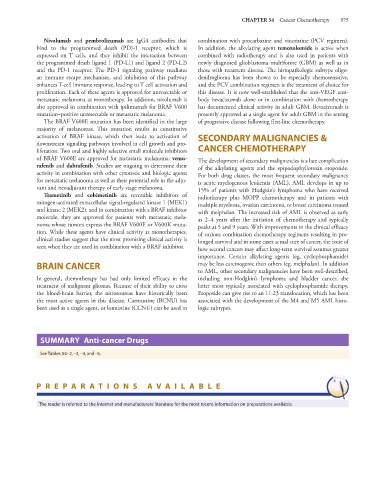Page 989 - Basic _ Clinical Pharmacology ( PDFDrive )
P. 989
CHAPTER 54 Cancer Chemotherapy 975
Nivolumab and pembrolizumab are IgG4 antibodies that combination with procarbazine and vincristine (PCV regimen).
bind to the programmed death (PD)-1 receptor, which is In addition, the alkylating agent temozolomide is active when
expressed on T cells, and they inhibit the interaction between combined with radiotherapy and is also used in patients with
the programmed death ligand 1 (PD-L1) and ligand 2 (PD-L2) newly diagnosed glioblastoma multiforme (GBM) as well as in
and the PD-1 receptor. The PD-1 signaling pathway mediates those with recurrent disease. The histopathologic subtype oligo-
an immune escape mechanism, and inhibition of this pathway dendroglioma has been shown to be especially chemosensitive,
enhances T-cell immune response, leading to T cell activation and and the PCV combination regimen is the treatment of choice for
proliferation. Each of these agents is approved for unresectable or this disease. It is now well-established that the anti-VEGF anti-
metastatic melanoma as monotherapy. In addition, nivolumab is body bevacizumab alone or in combination with chemotherapy
also approved in combination with ipilimumab for BRAF V600 has documented clinical activity in adult GBM. Bevacizumab is
mutation–positive unresectable or metastatic melanoma. presently approved as a single agent for adult GBM in the setting
The BRAF V600E mutation has been identified in the large of progressive disease following first-line chemotherapy.
majority of melanomas. This mutation results in constitutive
activation of BRAF kinase, which then leads to activation of SECONDARY MALIGNANCIES &
downstream signaling pathways involved in cell growth and pro-
liferation. Two oral and highly selective small molecule inhibitors CANCER CHEMOTHERAPY
of BRAF V600E are approved for metastatic melanoma: vemu- The development of secondary malignancies is a late complication
rafenib and dabrafenib. Studies are ongoing to determine their of the alkylating agents and the epipodophyllotoxin etoposide.
activity in combination with other cytotoxic and biologic agents For both drug classes, the most frequent secondary malignancy
for metastatic melanoma as well as their potential role in the adju- is acute myelogenous leukemia (AML). AML develops in up to
vant and neoadjuvant therapy of early stage melanoma. 15% of patients with Hodgkin’s lymphoma who have received
Trametinib and cobimetinib are reversible inhibitors of radiotherapy plus MOPP chemotherapy and in patients with
mitogen-activated extracellular signal-regulated kinase 1 (MEK1) multiple myeloma, ovarian carcinoma, or breast carcinoma treated
and kinase 2 (MEK2), and in combination with a BRAF inhibitor with melphalan. The increased risk of AML is observed as early
molecule, they are approved for patients with metastatic mela- as 2–4 years after the initiation of chemotherapy and typically
noma whose tumors express the BRAF V600E or V600K muta- peaks at 5 and 9 years. With improvements in the clinical efficacy
tion. While these agents have clinical activity as monotherapies, of various combination chemotherapy regimens resulting in pro-
clinical studies suggest that the most promising clinical activity is longed survival and in some cases actual cure of cancer, the issue of
seen when they are used in combination with a BRAF inhibitor. how second cancers may affect long-term survival assumes greater
importance. Certain alkylating agents (eg, cyclophosphamide)
BRAIN CANCER may be less carcinogenic than others (eg, melphalan). In addition
to AML, other secondary malignancies have been well-described,
In general, chemotherapy has had only limited efficacy in the including non-Hodgkin’s lymphoma and bladder cancer, the
treatment of malignant gliomas. Because of their ability to cross latter most typically associated with cyclophosphamide therapy.
the blood-brain barrier, the nitrosoureas have historically been Etoposide can give rise to an 11:23 translocation, which has been
the most active agents in this disease. Carmustine (BCNU) has associated with the development of the M4 and M5 AML histo-
been used as a single agent, or lomustine (CCNU) can be used in logic subtypes.
SUMMARY Anti-cancer Drugs
See Tables 54–2, –3, –4, and –5.
PREP AR A TIONS A V AIL ABLE
The reader is referred to the Internet and manufacturers’ literature for the most recent information on preparations available.

